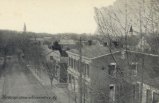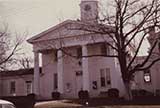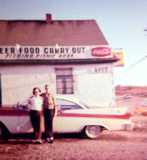Bird's Eye View of Alexandria
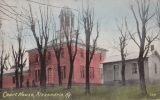 |
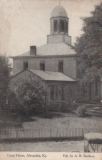 |
 |
Alexandria's Campbell |
Court House, |
Campbell County |
1966
![]()
“Newport Leader: The grand jury at Alexandria have brought in indictments against several farmers for
picking strawberries on Sunday.” Courier-Journal, July 25, 1876, quoting the Newport Leader.
![]()
Main Street, 1955
Scene of a sniper shooting one Halloween
1939 History of Alexandria High School
 |
 |
C. E. McCormick Vocational |
Campbell County |
The Alexandria Band
From a Facebook post by Buck Seibert
 |
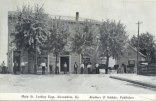 |
| Looking West on Main Street, 1911 | Looking East on Main Street, 1911 |
“Old Alexandria Jail where Jackson and Walling were confined”
Don't know who Jackson and Walling were? Know anything
about a headless corpse found in Fort Thomas?
Find out here.
A few words on the prior jail are here.
“The citizens of Alexandria, to which Jackson and Walling were removed, are
circulating a petition to Judge Helm asking that the execution be held in
their town.”
from the Richmond, Kentucky, Climax, March 10, 1897
A toll gate, somewhere in Alexandria
 |
 |
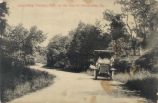 |
| My Old Kentucky Home, on the way to Alexandria |
Devil's Elbow, on the Way to Alexandria |
Ascending Youtsey Hill, on the Way to Alexandria |
The Crane Trace and Alexandria Turnpike is authorized. 1868.
Alexandria Cemetery
Officially established in 1873
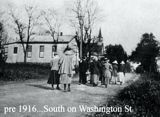
Washington Street
From a Facebook post by Matt Milner
 |
 |
 |
Alexandria VFD, 1941 |
Alexandria Fire |
Alexandria Fire |
![]()
Night Riders wreak damage near Alexandria in 1907, story here.
If you're not familiar with the Kentucky Tobacco Wars, the Night Riders, and The Equity, you should start here.
![]()
 |
| Alexandria, 1948 |
 |
 |
| South from Alexandria | “Cows near Keiser, near Alexandria, Kentucky” |
 |
 |
 |
 |
Early Alexandria Fair Scenes
Strawberry planted on the wide-matted row system, near
Alexandria, August, 1917
![]()
| “Newport, Ky., Aug. 1 [1904] - If you own an auto car keep off the Alexandria pike, leading out of Newport. The board of directors of that corporation have placed an almost prohibitive rate of one cent a mile for each horsepower of the machine that travels the thoroughfare, and as the majority of the autos are of at least 20 horsepower, that means a rate of 20 cents a mile for the privilege of running over the road. As a matter of fact, the directors do not want the "red devils" on the Alexandria pike and are taking this means of keeping them elsewhere.” from the Warsaw Independent, August 6, 1904 |
![]()
| “We learn from Mr. J. P. Crane that on Thursday evening last, near one fourth of the village of Alexandria, Ky., was consumed by fire. The principal sufferers were Mr. Brown, the Postmaster, his dwelling, store, and goods. Dr. Orr was completely burnt out.” Louisville Morning Courier, May 18, 1847 | “A fire occurred in Alexandria, Ky., which completely destroyed one house, and would, perhaps have burnt half the town had not the men and women of the village turned out and bravely worked – passing along the buckets of water in the absence of a fire engine.” Evansville (Ind) Daily Journal, February 26, 1859 |
| “The Veteran Volunteer Fireman's association of Louisville has just received an old leather bucket which was once used by George Washington in fighting a fire at Alexandria, Ky.” from Standford, Ky.'s Semi-Weekly Interior, December 31, 1897 | “Heavy Defalcation. – The Louisville Democrat says that F. & G. W. Brown, of Alexandria, Kentucky, have absconded, carrying with them about $100,000. They had received the money on deposit from various citizens of Campbell county.” Sacramento Daily Union, October 10, 1866 |
 New York Observer and Chronicle, March 28, 1867 |
The secessionists meet in in Alexandria in 1862. |
| Alexandria “Union man” found smuggling arms to the south, here. | |
| Dr. N. G. Zinn was a county-style doctor in the first half of the 20th century. Read about him here. | Another feature about Alexandria's Dr. N. G. Zinn. |
| “Alexandria has five hundred population. Of these only eight are professionals, to wit: five lawyers and three doctors. She has four large stores, the same number of taverns, one coffee-house, three blacksmith shops, one steam saw and flouring mill and one brewery.” Courier-Journal, June 7, 1875, quoting the Newport Leader. | |
 Cincinnati Daily Press, November 9, 1861 Cincinnati Daily Press, November 9, 1861 |
5,000 people in Alexandria celebrate the Bicentennial in 1883. That would be the Bicentennial of German emigration to America. Read about it here. |
 Kentucky Post, August 2, 1895 |
|
| Distraught beau shoots self. | Morehead has this (pdf) history of Alexandria from the WPA. |
| Henry Smith and Alexander Peacock fight a duel over a woman in Alexandria. Details here. Sequel here. | An early wine maker in Alexandria makes this report. |
| In 1834, the Kentucky Legislature passed an ACT making a 12 acre site laid out by Frank Spillman into a real town. They called it Alexandria. In 1856, they did it again. | |
Elizabeth Morrow Cooley's Early Days of Alexandria, Kentucky is here. (pdf) |
Robert Alexander Robertson or maybe Robinson is hung in Alexandria in 1852. Story's here, and here and here. |
| “There was a great Barbeque of the friends of the American party in Campbell county, Ky., on Saturday last. Fully 5,000 persons were present. The American principles have taken a strong hold in that region.“ Weekly Reveille (Vevay, Ind) August 1, 1855 (The American Party, also known as the Know-Nothing Party, was a prominent United States political party during the late 1840s and the early 1850s. Its members strongly opposed immigrants and followers of the Catholic Church. Read more at Wikipedia. 5,000 anti-Catholics, in Alexandria, in 1855?!? | |
| “It is reported today that the immense district of woodland in Campbell County, Kentucky is on fire and the flames spreading with fearful rapidity. There is much excitement in Alexandria. thirteen miles from Newport, which is said to be threatened.” NY Times, Oct. 22, 1871 | “John Abbott, who resides near Alexandria, in Campbell county, has been sued for $10,000 damages by Mary Lewis, who claims that he courted her five years and promised to marry her, but failed to do so.” Courier-Journal, February 15, 1870 |
| “Alien gangsters strew tacks and nails along the road to the Alexandria fairgrounds where the Women of the Ku Klux Klan are conducting a meeting.” The Fiery Cross, Indianapolis, August 24, 1924. The Fiery Cross was the official Klan newspaper | Alexandria established a lodge of the American Protestant Association in 1870. |
| Aunt Hagar dies at age 118. Or maybe “only” 108. Here. | |
| “Cassius M. Clay (Wikipedia) in response to a request from the citizens of that place, will speak at Alexandria, Ky., on Saturday, the 24th inst., upon 'the political questions which are now agitating the public mind.'” New York Herald, May 21, 1856 | The directors of the Newport and Alexandria Turnpike resolved to give free passage to all travelers for the Fourth of July in 1876. |
Info on earlier Campbell Courts, here. |
In 1930, the Kentucky Progress Magazine ran a story on William Haefner's fox farming operation in Alexandria. Read it here. (pdf) |
 |
| The Red Barn, earlier, Walt's Barn, From a Facebook post by Banjo Ramsey |
![]()
Map of Alexandria, 1883 from An Atlas of Boone, Kenton and Campbell Counties, Kentucky, published by D. J. Lake & Co.
![]()

